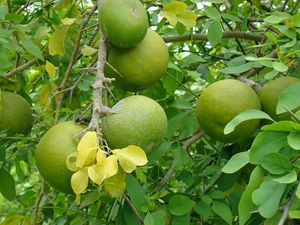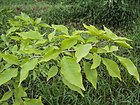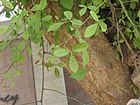Note: This is a project under development. The articles on this wiki are just being initiated and broadly incomplete. You can Help creating new pages.
Aegle marmelos - Bilva
Bilva consists of pulp of entire, unripe or half ripe fruits of Aegle marmelos Carr. (Fam. Rutaceae), a tree, attaining a height of 12 m growing wild and also cultivated throughout the country, rind of fruit is removed and pulp is bruised and dried[1]
Contents
- 1 Uses
- 2 Parts Used
- 3 Chemical Composition
- 4 Common names
- 5 Properties
- 6 Habit
- 7 Identification
- 8 List of Ayurvedic medicine in which the herb is used
- 9 Where to get the saplings
- 10 Mode of Propagation
- 11 How to plant/cultivate
- 12 Commonly seen growing in areas
- 13 Photo Gallery
- 14 References
- 15 External Links
Uses
Fever, Nasal bleeding, Diarrhoea, Skin disease, Intestinal worms, Cough, Diabetes, Vomiting, Cough, Stomach ache, Infection in intestine.
Parts Used
Chemical Composition
Marmalosin, tannins, mucilage, fatty oil and sugar.[2]
Common names
| Language | Common name |
|---|---|
| Kannada | Bilva |
| Hindi | Bela, Sriphal, Bel |
| Malayalam | Koovalam |
| Tamil | Vilvam |
| Telugu | Maredu |
| Marathi | Bel, Baela |
| Gujarathi | Bill, Bilum, Bilvaphal |
| Punjabi | Bil |
| Kashmiri | Bel |
| Sanskrit | Shreephala |
| English | Bengal Quince, Bael fruit |
Properties
Reference: Dravya - Substance, Rasa - Taste, Guna - Qualities, Veerya - Potency, Vipaka - Post-digesion effect, Karma - Pharmacological activity, Prabhava - Therepeutics.
Dravya
Rasa
Katu (Pungent), Tikta, Kashaya
Guna
Laghu (Light), Ruksha (Dry)
Veerya
Ushna (heat)
Vipaka
Katu (Pungent)
Karma
Balya, Deepana, Grahya, Paacana
Prabhava
Habit
Identification
Leaf
| Kind | Shape | Feature |
|---|---|---|
| alternate | trifoliate | Each leaflet 5-14 x 2–6 cm, ovate with tapering or pointed tip and rounded base, untoothed or with shallow rounded teeth. Young leaves are pale green or pinkish. |
Flower
| Type | Size | Color and composition | Stamen | More information |
|---|---|---|---|---|
| bisexual | 1.5 to 2 cm | pale green or yellowish | The four or five petals of 6–8 mm overlap in the bud and The ovary is bright green with an inconspicuous disc |
Fruit
| Type | Size | Mass | Appearance | Seeds | More information |
|---|---|---|---|---|---|
| globose or slightly pear-shaped | The bael fruit typically has a diameter of between 5 and 12 cm | many | Fruiting on summer and winter |
Other features
List of Ayurvedic medicine in which the herb is used
Where to get the saplings
Mode of Propagation
How to plant/cultivate
The bael fruit typically has a diameter of between 5 and 12 cm[4]
Commonly seen growing in areas
Tropical region, Temperate region.
Photo Gallery
References
- ↑ THE AYURVEDIC PHARMACOPOEIA OF INDIA, PART-I, VOLUME-1, page no 35.
- ↑ THE AYURVEDIC PHARMACOPOEIA OF INDIA, PART-I, VOLUME-1, page no 35."Constituents"
- ↑ "Morphology"
- ↑ Trophical plants of India
External Links
- Ayurvedic Herbs known to be helpful to treat Fever
- Ayurvedic Herbs known to be helpful to treat Nasal bleeding
- Ayurvedic Herbs known to be helpful to treat Diarrhoea
- Ayurvedic Herbs known to be helpful to treat Skin disease
- Ayurvedic Herbs known to be helpful to treat Intestinal worms
- Ayurvedic Herbs known to be helpful to treat Cough
- Ayurvedic Herbs known to be helpful to treat Diabetes
- Ayurvedic Herbs known to be helpful to treat Vomiting
- Ayurvedic Herbs known to be helpful to treat Stomach ache
- Ayurvedic Herbs known to be helpful to treat Infection in intestine
- Herbs with Seeds used in medicine
- Herbs with Leaves used in medicine
- Herbs with common name in Kannada
- Herbs with common name in Hindi
- Herbs with common name in Malayalam
- Herbs with common name in Tamil
- Herbs with common name in Telugu
- Herbs with common name in Marathi
- Herbs with common name in Gujarathi
- Herbs with common name in Punjabi
- Herbs with common name in Kashmiri
- Herbs with common name in Sanskrit
- Herbs with common name in English
- Habit - Tree
- Index of Plants which can be propagated by Seeds
- Herbs that are commonly seen in the region of Tropical region
- Herbs that are commonly seen in the region of Temperate region
- Herbs





